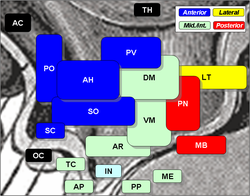The median eminence is generally defined as the portion of the ventral hypothalamus from which the portal vessels arise.[1] The median eminence is a small swelling on the tuber cinereum, posterior to and on top of the pituitary stalk; it lies in the area roughly bounded on its posterolateral region by the cerebral peduncles, and on its anterolateral region by the optic chiasm.
| Median eminence | |
|---|---|
 Median eminence is 'ME', at bottom-center, in light-green | |
| Details | |
| Identifiers | |
| Latin | eminentia mediana hypothalami |
| MeSH | D008473 |
| NeuroNames | 402 |
| NeuroLex ID | birnlex_925 |
| TA98 | A14.1.08.409 |
| TA2 | 5784 |
| FMA | 74634 |
| Anatomical terms of neuroanatomy | |
As one of the seven areas of the brain devoid of a blood–brain barrier,[2] the median eminence is a circumventricular organ having permeable capillaries.[3][4][5][6] Its main function is as a gateway for release of hypothalamic hormones,[7] although it does share contiguous perivascular spaces with the adjacent hypothalamic arcuate nucleus, indicating a potential sensory role.[4][8]
Physiology
editThe median eminence is a part of the hypothalamus from which regulatory hormones are released.[2][7] It is integral to the hypophyseal portal system, which connects the hypothalamus with the pituitary gland. The pars nervosa (part of the posterior pituitary gland) is continuous with the median eminence via the infundibular stalk. Parvocellular neurosecretory cells from the hypothalamus terminate in the median eminence.[9]
The median eminence is the structure where secretions of the hypothalamus (releasing and inhibiting hormones) regulatory hormones, known as "hypophysiotropic hormones") collect before entering the portal system emptying into the general circulation.[2][7] Such hypophysiotropic hormones include: CRF (corticotropin-releasing factor), GnRH (gonadotropin-releasing hormone), TRH (thyrotropin-releasing hormone), GHRH (growth hormone-releasing hormone), and DA (dopamine).[7] These hypophysiotropic hormones stimulate or inhibit the release of hormones from the anterior pituitary.[7] Further, anatomical evidence exists for bidirectional communication between the median eminence and the arcuate and ventromedial nucleus of the hypothalamus.[4][8]
References
edit- ^ Barrett, Kim E. (2019). Ganong's Review of Medical Physiology. Susan M. Barman, Heddwen L. Brooks, Jason X.-J. Yuan, William F. Preceded by: Ganong (26th ed.). [New York]. p. 303. ISBN 9781260122404. OCLC 1076268769.
{{cite book}}: CS1 maint: location missing publisher (link) - ^ a b c Gross PM, Weindl A (December 1987). "Peering through the windows of the brain". Journal of Cerebral Blood Flow and Metabolism. 7 (6): 663–72. doi:10.1038/jcbfm.1987.120. PMID 2891718.
- ^ Scott DE, Pepe GJ (July 1987). "The fetal baboon median eminence as a circumventricular organ: I. Transmission electron microscopy". Brain Research Bulletin. 19 (1): 87–94. doi:10.1016/0361-9230(87)90170-5. PMID 3651843. S2CID 26399150.
- ^ a b c Gross PM (1992). "Chapter 31: Circumventricular organ capillaries". Circumventricular Organs and Brain Fluid Environment - Molecular and Functional Aspects. Progress in Brain Research. Vol. 91. pp. 219–33. doi:10.1016/S0079-6123(08)62338-9. ISBN 9780444814197. PMID 1410407.
- ^ Johnson AK, Gross PM (May 1993). "Sensory circumventricular organs and brain homeostatic pathways". FASEB Journal. 7 (8): 678–86. doi:10.1096/fasebj.7.8.8500693. PMID 8500693. S2CID 13339562.
- ^ Ganong WF (2000). "Circumventricular organs: definition and role in the regulation of endocrine and autonomic function". Clinical and Experimental Pharmacology & Physiology. 27 (5–6): 422–7. doi:10.1046/j.1440-1681.2000.03259.x. PMID 10831247. S2CID 23652492.
- ^ a b c d e Palkovits M (1984). "Neuropeptides in the hypothalamo-hypophyseal system: lateral retrochiasmatic area as a common gate for neuronal fibers towards the median eminence". Peptides. 5 (Suppl 1): 35–9. doi:10.1016/0196-9781(84)90262-6. PMID 6148739. S2CID 3877865.
- ^ a b Shaver SW, Pang JJ, Wainman DS, Wall KM, Gross PM (March 1992). "Morphology and function of capillary networks in subregions of the rat tuber cinereum". Cell and Tissue Research. 267 (3): 437–48. doi:10.1007/BF00319366. PMID 1571958. S2CID 27789146.
- ^ Hall, John E. (2021). Guyton and Hall Textbook of Medical Physiology. Michael E. Hall (14th ed.). Philadelphia, PA. pp. 931–932. ISBN 978-0-323-59712-8. OCLC 1129099861.
{{cite book}}: CS1 maint: location missing publisher (link)